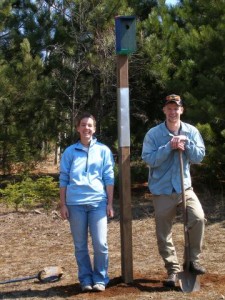Lynette Potvin ’08, currently an ecologist for the USDA Forest Service, Northern Research Station in Houghton, Research Scientist Dana Richter (SFRES), Professor Martin Jurgensen (SFRES) and colleague, published the paper, “Association of Pinus banksiana Lamb. and Populus tremuloides Michx. Seedling Fine Roots with Sistotrema Brinkmannii (Bres.) J. Erikss. (Basidiomycotina),” in Mycorrhiza (2012), Vol. 22:631-638. The paper, which came out of Potvin’s master’s research, describes a previously non-described interaction between a decay fungus and the roots of tree seedlings and their symbiotic fungi, the exact role of which remains a mystery. (Tech Today, Nov. 1, 2012)
| by Marcia Goodrich, Michigan Tech magazine editor
Pressure-treated wood is great stuff, but the chemicals used to preserve it from decay can leach out, where they can be toxic to bugs, fungi and other hapless creatures that have the bad luck to be in the neighborhood. Now, a team of scientists has used nanotechnology to keep the chemicals inside the wood where they belong. “It’s a new method that uses nanoparticles to deliver preservatives into the lumber,” said chemistry professor Patricia Heiden. “In our experiments, it reduced the leaching of biocides by 90 percent.” The nanoparticles are tiny spheres of gelatin or chitosan (a material found in the shells of shrimp and other shellfish) chemically modified to surround the fungicide tebuconazole. The little spheres require no special handling. “You just pressure-treat the wood in the usual way,” Heiden said. The initial tests show that the nanoparticle-treated wood is just as resistant to rot and insects as conventionally treated lumber. The researchers are now testing the wood in the warm, wet weather of Hawaii. The research is funded by the US Environmental Protection Agency. Also contributing to the project are chemistry PhD student Xiaochu Ding and, from the School of Forest Research and Environmental Science, Research Engineer/Scientist II Dana Richter, Senior Research Engineer/Scientist Glenn Larkin, Assistant Research Scientist Erik Keranen and Professor Peter Laks. |
Copper Country Audubon recently installed six bird houses at the Calumet waste-water treatment ponds about a mile west of Calumet on Hwy M-203. Thanks go to Supervisor Ken Hyrkas and Foreman Tom Buckett for approval and advice where to put the bird houses. The treatment ponds area is a great place for birds; birdwatchers often go there to observe waterfowl and song birds.

Two bird houses were also installed at the Waasa Cemetery. The birdhouses, made by VSI/Goodwill Industries of Houghton, are on eight and ten foot posts. They may be used by tree swallows, bluebirds, wood peckers and flycatchers.
The Michigan Tech Wildlife Club from the School of Forest Resources and Environmental Science assisted in the activity. Copper Country Audubon thanks its many members that provided funds for the project. Thanks are also extended to the municipalities who allow use of their property to h
elp increase bird nesting success in the area. For more information about Copper Country Audubon contact President Dana Richter, dlrichte@mtu.edu, 487-2149.
View more photos: http://www.flickr.com/photos/mtufres/5737272849/in/photostream
| Nearly 300 K-12 students from seven schools in Houghton, Baraga and Keweenaw counties ascended Brockway Mountain this spring, to view the annual raptor migration.
Research Engineer Dana Richter, forestry student Auriel Van De Laar, and members of the Copper Country Audubon Club helped students identify the raptors using binoculars, a spotting scope, and field guides–as well as learn about raptor characteristics and migration routes. Each spring, thousands of hawks, eagles and other raptors fly north along the Keweenaw Peninsula looking for a way to cross Lake Superior. As the birds reach the tip of the peninsula, some ride updrafts of warm air over Lake Superior, while others circle back and head for Duluth where they can follow the shoreline north. In April and May, people from all over the region visit this well-known scenic overlook for an, amazing view of raptors soaring by at eye level. Despite the popularity of the spring raptor migration among local and regional “birders,” few K-12 students have ever heard of the raptor migration. The Keweenaw Raptor Survey is a project of Copper Country Audubon and Laughing Whitefish Audubon of Marquette. Arthur Green (awg@gmx.us), a professional hawk-counter, is stationed on the mountain from March to June to count the raptors passing overhead. Sixteen species of raptors totaling almost 10,000 birds were counted in 2010. The 140 birds viewed on April 29 included: turkey vulture, osprey, bald eagle , northern harrier, sharp-shinned hawk, cooper’s hawk, northern goshawk, red-shouldered hawk, broad-winged hawk, red-tailed hawk, rough-legged hawk , golden American kestrel, merlin and peregrine falcon The staff of the Western UP Center for Science, Math and Environmental Education organized the event. For more information, visit: www.keweenawraptorsurvey.org . |